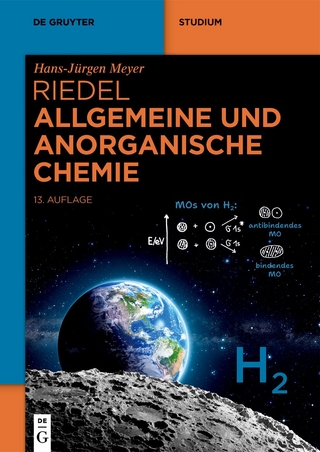Chemistry and Analysis of Radionuclides
Wiley-VCH (Verlag)
978-3-527-32658-7 (ISBN)
Professor Jukka Lehto is the head of the Laboratory of Radiochemistry at the Department of Chemistry, University of Helsinki. He attained his PhD degree in 1987 at the University of Helsinki. Since 1980 he has worked as a teaching assistant, senior lecturer at the University of Helsinki, visiting researcher at Texas A&M University, USA, senior research fellow of the Academy of Finland, acting professor and since 2005 as a professor in radiochemistry. Professor Lehto's main research areas have been nuclear waste management and disposal, and environmental radioactivity studies. He has published 160 scientific and technical papers and patents, and also published a book on the principles of radioactivity and radiochemistry in Finnish. Xiaolin Hou obtained his PhD degree in nuclear and radioanalytical chemistry from the Chinese Academy of Sciences in 1997. He joined Risø National Laboratory, Denmark, in 1998 (in 2007 Risø became part of the Technical University of Denmark), and has been a senior scientist there since 2003. His primary research interests are radiochemical and speciation analysis of radionuclides, nuclear and radioanalytical techniques, environmental radioactivity, radiotracer application, radiolabeling and protein adsorption on surfaces. Dr. Hou has authored/co-authored more than 110 research articles in peer reviewed scientific journals and 7 book chapters.
Preface
RADIONUCLIDES AND THEIR RADIOMETRIC MEASUREMENT
Radionuclides
Modes of Radioactive Decay
Detection and Measurement of Radiation
SPECIAL FEATURES OF THE CHEMISTRY OF RADIONUCLIDES AND THEIR SEPARATION
Small Quantities
Adsorption
Use of Carriers
Utilization of Radiation in the Determination of Radionuclides
Consideration of Elapsed Time
Changes in the System Caused by Radiation and Decay
The Need for Radiochemical Separations
FACTORS AFFECTING CHEMICAL FORMS OF RADIONUCLIDES IN AQUEOUS SOLUTIONS
Solution pH
Redox Potential
Dissolved Gases
Ligands Forming Complexes with Metals
Humic Substances
Colloidal Particles
Source and Generation of Radionuclides
Appendix: Reagents Used to Adjust Oxidation States of Radionuclides
SEPARATION METHODS
Precipitation
Solubility Product
Ion Exchange
Solvent Extraction
Extraction Chromatography
YIELD DETERMINATIONS AND COUNTING SOURCE PREPARATION
The Determination of Chemical Yield in Radiochemical Analyses
Preparation of Sources for Activity Counting
Essentials in Chemical Yield Determination and in Counting Source Preparation
RADIOCHEMISTRY OF THE ALKALI METALS
Most Important Radionuclides of the Alkali Metals
Chemical Properties of the Alkali Metals
Separation Needs of Alkali Metal Radionuclides
Potassium - 40K
Cesium - 134Cs, 135Cs, and 137Cs
Essentials in the Radiochemistry of the Alkali Metals
RADIOCHEMISTRY OF THE ALKALINE EARTH METALS
Most Important Radionuclides of the Alkaline Earth Metals
Chemical Properties of the Alkaline Earth Metals
Beryllium - 7Be and 10Be
Calcium - 41Ca and 45Ca
Strontium - 89Sr and 90Sr
Radium - 226Ra and 228Ra
Essentials in the Radiochemistry of the Alkaline Earth Metals
RADIOCHEMISTRY OF THE 3d-TRANSITION METALS
The Most Important Radionuclides of the 3d-Transition Metals
Chemical Properties of the 3d-Transition Metals
Iron - 55Fe
Nickel - 59Ni and 63Ni
Essentials in 3d-Transition Metals Radiochemistry
RADIOCHEMISTRY OF TE 4d-TRANSITION METALS
Important Radionuclides of the 4d-Transition Metals
Chemistry of the 4d-Transition Metals
Technetium - 99Tc
Zirconium - 93Zr
Molybdenum - 93Mo
Niobium - 94Nb
Essentials in the Radiochemistry of 4d-Transition Metals
RADIOCHEMISTRY OF THE LANTHANIDES
Important Lanthanide Radionuclides
Chemical Properties of the Lanthanides
Separation of Lanthanides from Actinides
Lanthanides as Actinide Analogs
147Pm and 151Am
Essentials of Lanthanide Radiochemistry
RADIOCHEMISTRY OF THE HALOGENS
Important Halogen Radionuclides
Physical and Chemical Properties of the Halogens
Chlorine -.36Cl
Iodine - 129I
Essentials of Halogen Radiochemistry
RADIOCHEMISTRY OF THE NOBLE GASES
Tritium - 3H
Radiocarbon - 14C
Essentials of Tritium and Radiocarbon Radiochemistry
RADIOCHEMISTRY OF LEAD, POLONIUM, TIN, AND SELENIUM
Polonium - 210Po
Lead - 210Pb
Tin - 126Sn
Selenium - 79Se
Essentials of Polonium, Lead, Tin, and Selenium Radiochemistry
RADIOCHEMISTRY OF THE ACTINIDES
Important Actinide Isotopes
Generation and Origin of the Actinides
Electronic Structures of the Actinides
Oxidation States of the Actinides
Ionic Radii of the Actinides
Major Chemical Forms of the Actinides
Disproportionation
Hydrolysis and Polymerization of the Actinides
Complex Formation of the Actinides
Oxides of the Actinides
Actinium
Thorium
Protactinium
Uranium
Neptunium
Plutonium
Americium and Curium
SPECIATION ANALYSIS
Considerations Relevant to Speciation
Significance of Speciation
Categorization of Speciation Analyzes
Fractionation Techniques for Environmental Samples
Analysis of Radionuclide and Isotope Compositions
Spectroscopic Speciation Methods
Wet Chemical Methods
Sequential Extractions
Computational Speciation Methods
Characterization of Radioactive Particles
MEASUREMENT OF RADIONUCLIDES BY MASS SPECTROMETRY
Introduction
Inductively Coupled Plasma Mass Spectrometry (ICP-MS)
Accelerator Mass Spectrometry (AMS)
Thermal Ionization Mass Spectrometry (TIMS)
Resonance Ionization Mass Spectrometry (RIMS)
Essentials of the Measurement of Radionuclides by Mass Spectrometry
SAMPLING AND SAMPLE PRETREATMENT FOR THE DETERMINATION OF RADIONUCLIDES
Introduction
Air Sampling and Pretreatment
Sampling Gaseous Components
Atmospheric Deposition Sampling
Water Sampling
Sediment Sampling and Pretreatment
Soil Sampling and Pretreatment
Essentials in Sampling and Sample Pretreatment
CHEMICAL CHANGES INDUCED BY RADIOACTIVE DECAY
Autoradiolysis
Transmutation and Subsequent Chemical Changes
Recoil - Hot Atom Chemistry
"So if you have chosen this book because of its promising subtitle ''Laboratory Techniques and Methodology'' you will not be disappointed." ( J Radioanal Nucl Chem , 23 September 2011)
| Erscheint lt. Verlag | 30.11.2010 |
|---|---|
| Sprache | englisch |
| Maße | 170 x 240 mm |
| Gewicht | 950 g |
| Themenwelt | Naturwissenschaften ► Chemie ► Anorganische Chemie |
| Schlagworte | Analytical Chemistry • Analytische Chemie • Anorganische Chemie • Chemie • Chemistry • Inorganic Chemistry • Physical Chemistry • Physikalische Chemie • Radionuklide • Toxicology • Toxikologie |
| ISBN-10 | 3-527-32658-8 / 3527326588 |
| ISBN-13 | 978-3-527-32658-7 / 9783527326587 |
| Zustand | Neuware |
| Informationen gemäß Produktsicherheitsverordnung (GPSR) | |
| Haben Sie eine Frage zum Produkt? |
aus dem Bereich




